Felix Heide
LSD-3D: Large-Scale 3D Driving Scene Generation with Geometry Grounding
Aug 26, 2025Abstract:Large-scale scene data is essential for training and testing in robot learning. Neural reconstruction methods have promised the capability of reconstructing large physically-grounded outdoor scenes from captured sensor data. However, these methods have baked-in static environments and only allow for limited scene control -- they are functionally constrained in scene and trajectory diversity by the captures from which they are reconstructed. In contrast, generating driving data with recent image or video diffusion models offers control, however, at the cost of geometry grounding and causality. In this work, we aim to bridge this gap and present a method that directly generates large-scale 3D driving scenes with accurate geometry, allowing for causal novel view synthesis with object permanence and explicit 3D geometry estimation. The proposed method combines the generation of a proxy geometry and environment representation with score distillation from learned 2D image priors. We find that this approach allows for high controllability, enabling the prompt-guided geometry and high-fidelity texture and structure that can be conditioned on map layouts -- producing realistic and geometrically consistent 3D generations of complex driving scenes.
Large-Area Fabrication-aware Computational Diffractive Optics
May 28, 2025Abstract:Differentiable optics, as an emerging paradigm that jointly optimizes optics and (optional) image processing algorithms, has made innovative optical designs possible across a broad range of applications. Many of these systems utilize diffractive optical components (DOEs) for holography, PSF engineering, or wavefront shaping. Existing approaches have, however, mostly remained limited to laboratory prototypes, owing to a large quality gap between simulation and manufactured devices. We aim at lifting the fundamental technical barriers to the practical use of learned diffractive optical systems. To this end, we propose a fabrication-aware design pipeline for diffractive optics fabricated by direct-write grayscale lithography followed by nano-imprinting replication, which is directly suited for inexpensive mass production of large area designs. We propose a super-resolved neural lithography model that can accurately predict the 3D geometry generated by the fabrication process. This model can be seamlessly integrated into existing differentiable optics frameworks, enabling fabrication-aware, end-to-end optimization of computational optical systems. To tackle the computational challenges, we also devise tensor-parallel compute framework centered on distributing large-scale FFT computation across many GPUs. As such, we demonstrate large scale diffractive optics designs up to 32.16 mm $\times$ 21.44 mm, simulated on grids of up to 128,640 by 85,760 feature points. We find adequate agreement between simulation and fabricated prototypes for applications such as holography and PSF engineering. We also achieve high image quality from an imaging system comprised only of a single DOE, with images processed only by a Wiener filter utilizing the simulation PSF. We believe our findings lift the fabrication limitations for real-world applications of diffractive optics and differentiable optical design.
VERDI: VLM-Embedded Reasoning for Autonomous Driving
May 21, 2025Abstract:While autonomous driving (AD) stacks struggle with decision making under partial observability and real-world complexity, human drivers are capable of commonsense reasoning to make near-optimal decisions with limited information. Recent work has attempted to leverage finetuned Vision-Language Models (VLMs) for trajectory planning at inference time to emulate human behavior. Despite their success in benchmark evaluations, these methods are often impractical to deploy (a 70B parameter VLM inference at merely 8 tokens per second requires more than 160G of memory), and their monolithic network structure prohibits safety decomposition. To bridge this gap, we propose VLM-Embedded Reasoning for autonomous Driving (VERDI), a training-time framework that distills the reasoning process and commonsense knowledge of VLMs into the AD stack. VERDI augments modular differentiable end-to-end (e2e) AD models by aligning intermediate module outputs at the perception, prediction, and planning stages with text features explaining the driving reasoning process produced by VLMs. By encouraging alignment in latent space, \textsc{VERDI} enables the modular AD stack to internalize structured reasoning, without incurring the inference-time costs of large VLMs. We demonstrate the effectiveness of our method on the NuScenes dataset and find that VERDI outperforms existing e2e methods that do not embed reasoning by 10% in $\ell_{2}$ distance, while maintaining high inference speed.
Scenario Dreamer: Vectorized Latent Diffusion for Generating Driving Simulation Environments
Mar 28, 2025Abstract:We introduce Scenario Dreamer, a fully data-driven generative simulator for autonomous vehicle planning that generates both the initial traffic scene - comprising a lane graph and agent bounding boxes - and closed-loop agent behaviours. Existing methods for generating driving simulation environments encode the initial traffic scene as a rasterized image and, as such, require parameter-heavy networks that perform unnecessary computation due to many empty pixels in the rasterized scene. Moreover, we find that existing methods that employ rule-based agent behaviours lack diversity and realism. Scenario Dreamer instead employs a novel vectorized latent diffusion model for initial scene generation that directly operates on the vectorized scene elements and an autoregressive Transformer for data-driven agent behaviour simulation. Scenario Dreamer additionally supports scene extrapolation via diffusion inpainting, enabling the generation of unbounded simulation environments. Extensive experiments show that Scenario Dreamer outperforms existing generative simulators in realism and efficiency: the vectorized scene-generation base model achieves superior generation quality with around 2x fewer parameters, 6x lower generation latency, and 10x fewer GPU training hours compared to the strongest baseline. We confirm its practical utility by showing that reinforcement learning planning agents are more challenged in Scenario Dreamer environments than traditional non-generative simulation environments, especially on long and adversarial driving environments.
Dual Exposure Stereo for Extended Dynamic Range 3D Imaging
Dec 03, 2024
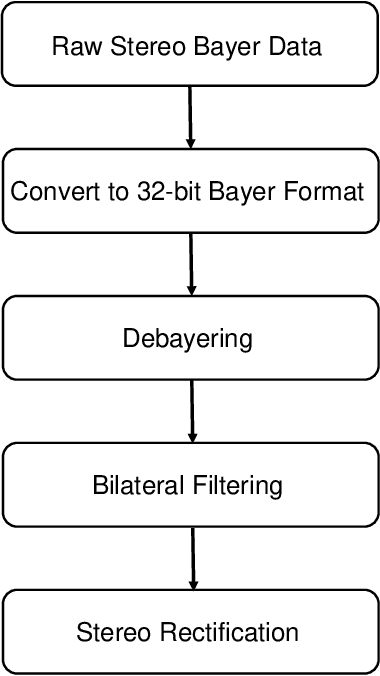

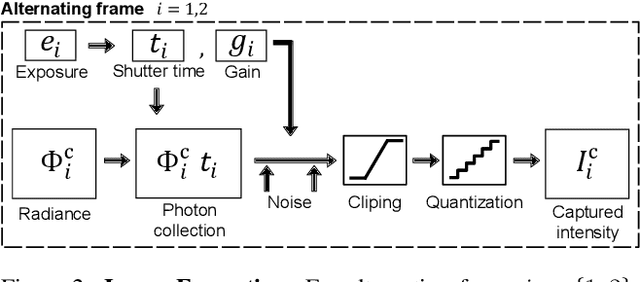
Abstract:Achieving robust stereo 3D imaging under diverse illumination conditions is an important however challenging task, due to the limited dynamic ranges (DRs) of cameras, which are significantly smaller than real world DR. As a result, the accuracy of existing stereo depth estimation methods is often compromised by under- or over-exposed images. Here, we introduce dual-exposure stereo for extended dynamic range 3D imaging. We develop automatic dual-exposure control method that adjusts the dual exposures, diverging them when the scene DR exceeds the camera DR, thereby providing information about broader DR. From the captured dual-exposure stereo images, we estimate depth using motion-aware dual-exposure stereo network. To validate our method, we develop a robot-vision system, collect stereo video datasets, and generate a synthetic dataset. Our method outperforms other exposure control methods.
SimCMF: A Simple Cross-modal Fine-tuning Strategy from Vision Foundation Models to Any Imaging Modality
Nov 27, 2024



Abstract:Foundation models like ChatGPT and Sora that are trained on a huge scale of data have made a revolutionary social impact. However, it is extremely challenging for sensors in many different fields to collect similar scales of natural images to train strong foundation models. To this end, this work presents a simple and effective framework, SimCMF, to study an important problem: cross-modal fine-tuning from vision foundation models trained on natural RGB images to other imaging modalities of different physical properties (e.g., polarization). In SimCMF, we conduct a thorough analysis of different basic components from the most naive design and ultimately propose a novel cross-modal alignment module to address the modality misalignment problem. We apply SimCMF to a representative vision foundation model Segment Anything Model (SAM) to support any evaluated new imaging modality. Given the absence of relevant benchmarks, we construct a benchmark for performance evaluation. Our experiments confirm the intriguing potential of transferring vision foundation models in enhancing other sensors' performance. SimCMF can improve the segmentation performance (mIoU) from 22.15% to 53.88% on average for evaluated modalities and consistently outperforms other baselines. The code is available at https://github.com/mt-cly/SimCMF
Neural Light Spheres for Implicit Image Stitching and View Synthesis
Sep 26, 2024
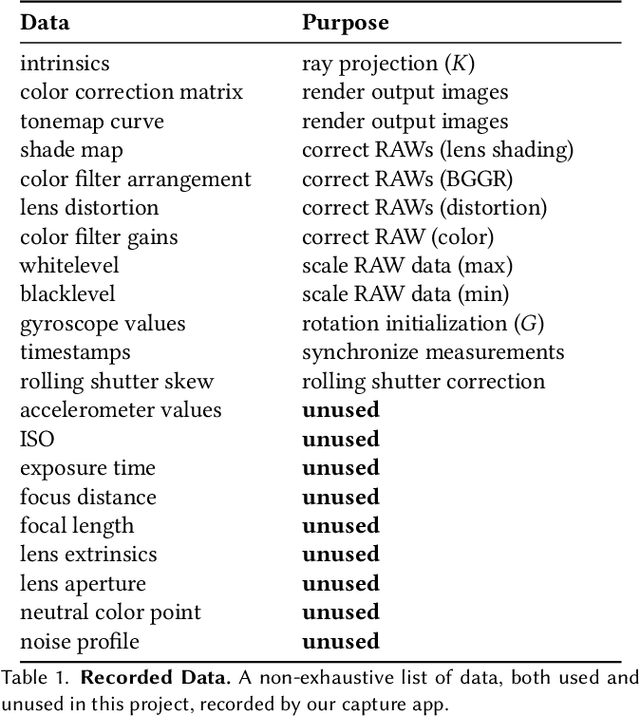

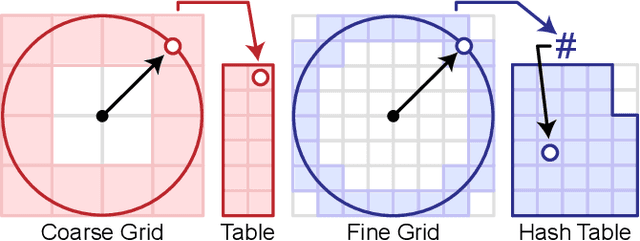
Abstract:Challenging to capture, and challenging to display on a cellphone screen, the panorama paradoxically remains both a staple and underused feature of modern mobile camera applications. In this work we address both of these challenges with a spherical neural light field model for implicit panoramic image stitching and re-rendering; able to accommodate for depth parallax, view-dependent lighting, and local scene motion and color changes during capture. Fit during test-time to an arbitrary path panoramic video capture -- vertical, horizontal, random-walk -- these neural light spheres jointly estimate the camera path and a high-resolution scene reconstruction to produce novel wide field-of-view projections of the environment. Our single-layer model avoids expensive volumetric sampling, and decomposes the scene into compact view-dependent ray offset and color components, with a total model size of 80 MB per scene, and real-time (50 FPS) rendering at 1080p resolution. We demonstrate improved reconstruction quality over traditional image stitching and radiance field methods, with significantly higher tolerance to scene motion and non-ideal capture settings.
SimMAT: Exploring Transferability from Vision Foundation Models to Any Image Modality
Sep 12, 2024



Abstract:Foundation models like ChatGPT and Sora that are trained on a huge scale of data have made a revolutionary social impact. However, it is extremely challenging for sensors in many different fields to collect similar scales of natural images to train strong foundation models. To this end, this work presents a simple and effective framework SimMAT to study an open problem: the transferability from vision foundation models trained on natural RGB images to other image modalities of different physical properties (e.g., polarization). SimMAT consists of a modality-agnostic transfer layer (MAT) and a pretrained foundation model. We apply SimMAT to a representative vision foundation model Segment Anything Model (SAM) to support any evaluated new image modality. Given the absence of relevant benchmarks, we construct a new benchmark to evaluate the transfer learning performance. Our experiments confirm the intriguing potential of transferring vision foundation models in enhancing other sensors' performance. Specifically, SimMAT can improve the segmentation performance (mIoU) from 22.15% to 53.88% on average for evaluated modalities and consistently outperforms other baselines. We hope that SimMAT can raise awareness of cross-modal transfer learning and benefit various fields for better results with vision foundation models.
Polarization Wavefront Lidar: Learning Large Scene Reconstruction from Polarized Wavefronts
Jun 05, 2024



Abstract:Lidar has become a cornerstone sensing modality for 3D vision, especially for large outdoor scenarios and autonomous driving. Conventional lidar sensors are capable of providing centimeter-accurate distance information by emitting laser pulses into a scene and measuring the time-of-flight (ToF) of the reflection. However, the polarization of the received light that depends on the surface orientation and material properties is usually not considered. As such, the polarization modality has the potential to improve scene reconstruction beyond distance measurements. In this work, we introduce a novel long-range polarization wavefront lidar sensor (PolLidar) that modulates the polarization of the emitted and received light. Departing from conventional lidar sensors, PolLidar allows access to the raw time-resolved polarimetric wavefronts. We leverage polarimetric wavefronts to estimate normals, distance, and material properties in outdoor scenarios with a novel learned reconstruction method. To train and evaluate the method, we introduce a simulated and real-world long-range dataset with paired raw lidar data, ground truth distance, and normal maps. We find that the proposed method improves normal and distance reconstruction by 53\% mean angular error and 41\% mean absolute error compared to existing shape-from-polarization (SfP) and ToF methods. Code and data are open-sourced at https://light.princeton.edu/pollidar.
Gated Fields: Learning Scene Reconstruction from Gated Videos
May 30, 2024


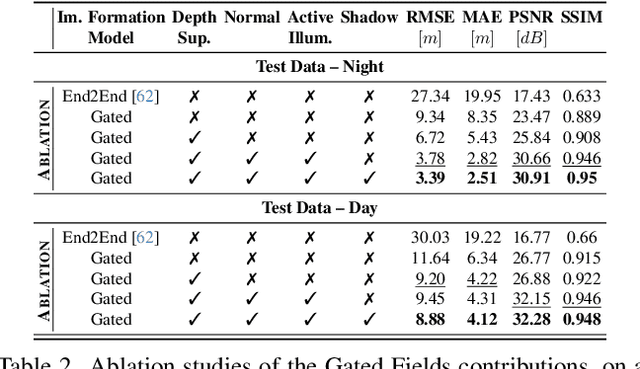
Abstract:Reconstructing outdoor 3D scenes from temporal observations is a challenge that recent work on neural fields has offered a new avenue for. However, existing methods that recover scene properties, such as geometry, appearance, or radiance, solely from RGB captures often fail when handling poorly-lit or texture-deficient regions. Similarly, recovering scenes with scanning LiDAR sensors is also difficult due to their low angular sampling rate which makes recovering expansive real-world scenes difficult. Tackling these gaps, we introduce Gated Fields - a neural scene reconstruction method that utilizes active gated video sequences. To this end, we propose a neural rendering approach that seamlessly incorporates time-gated capture and illumination. Our method exploits the intrinsic depth cues in the gated videos, achieving precise and dense geometry reconstruction irrespective of ambient illumination conditions. We validate the method across day and night scenarios and find that Gated Fields compares favorably to RGB and LiDAR reconstruction methods. Our code and datasets are available at https://light.princeton.edu/gatedfields/.
 Add to Chrome
Add to Chrome Add to Firefox
Add to Firefox Add to Edge
Add to Edge